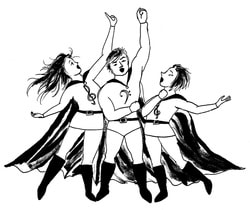Adventures in Sightsinging

Bob Worth, Sonoma Bach's music director, and Shawna Hervé, a music teacher and alto with two of our groups, co-teach a lively class intended to help singers develop fluent music reading. We'll focus on pitch and rhythm skills, and also on strategies for comprehending larger patterns--where the music is headed. Intended for beginning to intermediate sightsingers.
As per our session on Thursday, March 18, the PDF score packet of Scheidt Görlitzer Chorales is available here.
In addition, zip files of the chorales are available in the following four formats:
Scheidt Görlitzer Audio Files: These are simply recordings of the scores, at a moderate tempo, in a guitar sound.
For use with the PDF packet, either on your screen or printed out.
Scheidt Görlitzer MuseScore Files: These are for use with the free MuseScore notation program discussed in our session. You can obtain the software here. Once you do, try opening a file from the 'MuseScore Files' folder. Click the File menu, select 'Open', navigate to the location in which you saved the files, and double-click the file you want to try.
Once the file opens, I suggest selecting 'Continuous View' (as opposed to 'Page View') in the top bar--it may already be selected--and under the 'View' menu, make sure that 'Mixer' is selected. The simple play controls are in the top bar: Right-pointing triangle for Start or Stop, Rewind to return to the beginning.
In the mixer (on the right), you can change volume for each track with the sliders. The green 'S' button allows you to pay only that track; the red 'M' button silences that track; the little 'knob' controls the pan--click in the knob and drag up to pan that track to the left in the stereo mix; drag down to pan to the right.
Finally, you can change the tempo by double-clicking the metronome marking at the beginning of the score (if you can't see it, just hit the rewind button in the top bar)--a little grey box will appear around it; then double-click the number; then type in a higher or lower number.
Because MuseScore clearly displays the score, and (in 'Continuous View') scrolls as it plays, you will be able to read the music directly from your device. You may however wish to have a printout of the PDF packet available
for consultation or score marking.
Scheidt Görlitzer MusicXML Files: These are for use in a notation program other than MuseScore. If you have a notation program that you like and are adept at using, simply open these files from within that program.
Scheidt Görlitzer Midi Files: These files are for use with a MIDI program, if you have one
In addition, zip files of the chorales are available in the following four formats:
Scheidt Görlitzer Audio Files: These are simply recordings of the scores, at a moderate tempo, in a guitar sound.
For use with the PDF packet, either on your screen or printed out.
Scheidt Görlitzer MuseScore Files: These are for use with the free MuseScore notation program discussed in our session. You can obtain the software here. Once you do, try opening a file from the 'MuseScore Files' folder. Click the File menu, select 'Open', navigate to the location in which you saved the files, and double-click the file you want to try.
Once the file opens, I suggest selecting 'Continuous View' (as opposed to 'Page View') in the top bar--it may already be selected--and under the 'View' menu, make sure that 'Mixer' is selected. The simple play controls are in the top bar: Right-pointing triangle for Start or Stop, Rewind to return to the beginning.
In the mixer (on the right), you can change volume for each track with the sliders. The green 'S' button allows you to pay only that track; the red 'M' button silences that track; the little 'knob' controls the pan--click in the knob and drag up to pan that track to the left in the stereo mix; drag down to pan to the right.
Finally, you can change the tempo by double-clicking the metronome marking at the beginning of the score (if you can't see it, just hit the rewind button in the top bar)--a little grey box will appear around it; then double-click the number; then type in a higher or lower number.
Because MuseScore clearly displays the score, and (in 'Continuous View') scrolls as it plays, you will be able to read the music directly from your device. You may however wish to have a printout of the PDF packet available
for consultation or score marking.
Scheidt Görlitzer MusicXML Files: These are for use in a notation program other than MuseScore. If you have a notation program that you like and are adept at using, simply open these files from within that program.
Scheidt Görlitzer Midi Files: These files are for use with a MIDI program, if you have one
Need help? [email protected]
